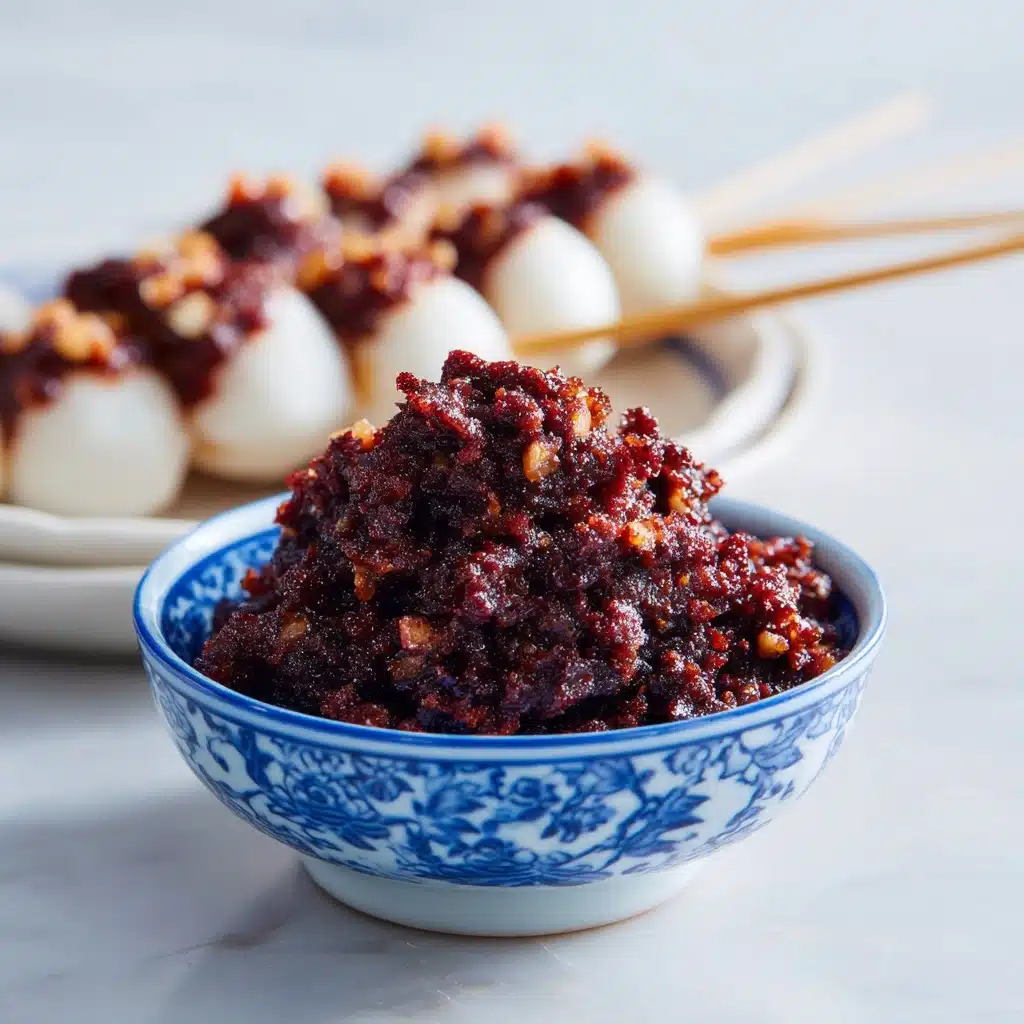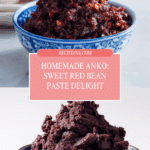Anko Recipe – Japanese Sweet Red Bean Paste Recipe
If there’s one staple that perfectly captures the soul of Japanese confections, it’s Anko Recipe – Japanese Sweet Red Bean Paste. Silky, sweet, and utterly nostalgic, this homemade version transforms humble azuki beans into a delicious treat that stars in classics like mochi, dorayaki, and taiyaki. Whip up a batch, and your kitchen will be filled with the delicate aroma of simmered beans and sugar — pure happiness, spooned right from the pot!

Ingredients You’ll Need
For Anko Recipe – Japanese Sweet Red Bean Paste, simplicity really shines. You only need a handful of ingredients, but every single one plays a crucial role in creating the creamy and nuanced paste that’s beloved across Japan.
- Azuki Beans: These small red beans are the heart of this recipe; their subtle flavor and beautiful burgundy color are iconic.
- Sugar: Standard granulated sugar sweetens the beans and helps them break down into a luscious paste.
- Salt: Just a pinch balances the sweetness and deepens the flavor — don’t skip it!
- Boiling Water: Having plenty on hand is essential for softening the beans and keeping them tender as they cook.
- Cold Water: This helps with the simmering stages, ensuring your beans become creamy without burning or sticking.
How to Make Anko Recipe – Japanese Sweet Red Bean Paste
Step 1: Wash and Soak the Azuki Beans
Begin by giving your azuki beans a thorough rinse under cold water to remove any dust or debris. Place them in a saucepan, cover with boiling water about 1 cm (or half an inch) above the top, and let the beans soak for 30 minutes. This soaking softens the skins, making for a creamier texture in your final Anko Recipe – Japanese Sweet Red Bean Paste.
Step 2: First Boil and Drain
After soaking, place the beans on high heat and bring to a boil. Boil uncovered until nearly all the liquid is gone, about 15 minutes. The water should turn a murky red-brown as it draws out some of the bean’s bitterness. Drain off any remaining water to reset the flavor for the next simmer.
Step 3: Second and Third Simmer
Add 2 cups of cold water to the drained beans and bring back up to a boil. Let it simmer for 15 minutes, stirring occasionally to keep the beans from sticking. Once the water level drops below the beans, add another 2 cups of cold water and repeat the simmer for another 15 minutes. These repeated simmers help soften the beans evenly and make the paste extra smooth.
Step 4: Sweeten and Thicken
Once the water has again gone below the bean line, lower the heat to medium-low and sprinkle in your sugar and a pinch of salt. Stir well, letting the sugar dissolve into the gently bubbling beans. The mixture will deepen in color and start to thicken — keep an eye on it so it doesn’t stick to the bottom.
Step 5: Test for Doneness
After about 10 minutes of cooking with the sugar, do a quick “smoosh” test: pick up a bean and see if it mashes easily between your fingers. If it’s still firm, stir in an extra half to one cup of water and give it another 10 minutes on the heat. Perfect anko is always tender, never gritty!
Step 6: Mash to Your Preferred Consistency
Take the pan off the heat and grab a potato masher or the back of a wooden spoon. Gently mash until about half the beans have broken down and you’re left with a paste that’s smooth but still a little chunky — this is the classic “tsubuan” style. If you want an ultra-smooth paste, push the mixture through a fine sieve for “koshian” style.
Step 7: Cool and Serve
Let your Anko Recipe – Japanese Sweet Red Bean Paste cool slightly before using. It’ll thicken up as it sits and is now ready to be spooned over dango, sandwiched in pancakes, or simply enjoyed with a cup of green tea.
How to Serve Anko Recipe – Japanese Sweet Red Bean Paste

Garnishes
Dress up your anko by scattering toasted sesame seeds or a sprinkling of kinako (roasted soybean flour) on top. These simple garnishes add both texture and earthy notes, making your red bean paste even more irresistible and authentic.
Side Dishes
Pair the sweet richness of Anko Recipe – Japanese Sweet Red Bean Paste with gentle, palate-cleansing sides. Think: a bowl of matcha tea, crisp pickled cucumbers for contrast, or freshly sliced fruit like sweet strawberries or pears — all a perfect balance to the paste’s natural depth.
Creative Ways to Present
Move beyond tradition and get playful! Swirl anko through yogurt, stuff it inside crepes or French toast, or fold it into ice cream for an unexpected fusion treat. Your homemade batch is an open invitation to experiment with Japanese flavors in new contexts!
Make Ahead and Storage
Storing Leftovers
Once cool, transfer leftover paste into an airtight container. It will happily keep in the fridge for up to five days, ready for quick desserts or afternoon snacks. Always use a clean spoon to keep it fresh and free from cross-contamination.
Freezing
For longer storage, freezing is ideal. Spoon the paste into small, portioned containers or even into ice cube trays for easy serving sizes. Once frozen, transfer the cubes to a heavy-duty freezer bag. Anko Recipe – Japanese Sweet Red Bean Paste will keep in the freezer for up to three months without losing flavor or texture.
Reheating
Defrost overnight in the refrigerator or at room temperature if you’re in a hurry. Gently warm the paste in a saucepan over low heat, adding a splash of water if it looks too thick. Stir until soft and glossy — it’s ready to use again!
FAQs
Can I use canned azuki beans instead of dried?
Yes, if you’re pressed for time, canned azuki beans can stand in for dried. Be sure to rinse them well and shorten the cooking time, adjusting the water so your paste isn’t overly watery.
What’s the difference between tsubuan and koshian?
Tsubuan is chunky-style anko, where some whole beans remain, while koshian is ultra-smooth — perfect for delicate desserts. Both start from the same base, so you can easily make either from this recipe!
My beans are still tough after simmering. What went wrong?
Older beans often take longer to soften, as does hard water. Don’t hesitate to add a little extra water and keep simmering until they’re perfectly tender. Patience here is key to the creamiest paste.
Is Anko Recipe – Japanese Sweet Red Bean Paste gluten-free?
Absolutely! This recipe uses no grains or thickeners, so it’s naturally gluten-free, making it suitable for most dietary needs and a variety of desserts.
Can I control the sweetness level?
Of course. If you prefer your paste less sweet, begin with three-quarters of the recommended sugar, taste, and add more if you’d like. Homemade anko is all about making it just right for you.
Final Thoughts
You’ll find that making Anko Recipe – Japanese Sweet Red Bean Paste at home is as rewarding as it is delicious. Not only does it open up a world of Japanese desserts, but it also brings comfort and tradition right into your own kitchen. Give it a try and discover why this sweet bean paste is cherished far beyond Japan!
Print
Anko Recipe – Japanese Sweet Red Bean Paste Recipe
- Total Time: 1 hour 30 minutes
- Yield: About 2 cups 1x
- Diet: Vegetarian
Description
Learn how to make traditional Japanese sweet red bean paste, known as Anko, which is a versatile and sweet filling used in various Japanese desserts.
Ingredients
For Anko:
- 1 cup azuki beans (200g / 7oz)
- 1 cup sugar (200g / 7oz)
- 1 pinch salt
- Boiling water (enough to cover the beans 1 cm / 1/2 inch above the top)
- 5 cups water
Instructions
- Soak: Wash azuki beans. Pop in a saucepan and cover about 1cm / ½in above the beans with boiling water to allow them to soften for 30 mins.
- Boil: Next place the soaked beans and water on high heat and bring to the boil. Boil down until all the liquid has evaporated (around 15 minutes). Drain any excess water which should look a murky brown red.
- Boil: Add 2 cups of cold water and bring back to boil. Boil for another 15 minutes or until the water level goes below the beans. Stir occasionally to check no beans are sticking. Add another 2 cups of cold water and boil down again for another 15 minutes.
- Thicken: Once the water dips below the beans again, it’s time to add your sugar and pinch of salt and put the heat down to low-medium. This will allow the sugar to dissolve in the last of the water and be absorbed by the beans. At this stage the liquid should be dark and gently bubbling amongst the beans.
- Test: After 10 minutes the liquid should start to thicken. Do a ‘smoosh’ test first and squeeze an azuki bean to see if it squishes. If your beans aren’t soft enough, add another ½ – 1 cup of water and cook them for one last round (around 10 minutes).
- Mash: Now it’s time to mash, mash, mash! You want a nice consistency where it has a nice balance of smooth and texture.
- Serve: Your sweet red bean paste is now ready to use on your favourite Japanese desserts like mochi and dango!
- Prep Time: 30 minutes
- Cook Time: 1 hour
- Category: Dessert
- Method: Boiling, Mashing
- Cuisine: Japanese
Nutrition
- Serving Size: 1 tablespoon
- Calories: 45
- Sugar: 6g
- Sodium: 10mg
- Fat: 0g
- Saturated Fat: 0g
- Unsaturated Fat: 0g
- Trans Fat: 0g
- Carbohydrates: 10g
- Fiber: 1g
- Protein: 1g
- Cholesterol: 0mg
Keywords: Anko, Japanese sweet red bean paste, dessert, mochi, dango







